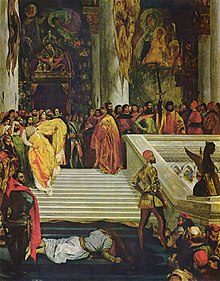Marino Faliero, Doge of Venice
(Przekierowano z Marino Faliero, Doge of Venice (Byron))


Marino Faliero, Doge of Venice – tragedia angielskiego romantyka George’a Gordona Byrona, opublikowana w 1821 w jednym tomie z poematem The Prophecy of Dante. Utwór opowiada historię weneckiego doży Marina Faliero, który został skazany na śmierć i stracony przez ścięcie 17 kwietnia 1355[1] za organizowanie buntu przeciwko arystokracji. Utwór składa się z pięciu aktów i jest napisany wierszem białym (blank verse).
- True; but there still is something given to guess.
- Which a shrewd gleaner and quick eyjs would catch at;
- A whisper, or a murmur, or an air
- More or less solemn spread o’’er the tribunal.
- The Forty are but men — most worthy men.
- And wise, and just, and cautious — this I grant —
- And secret as the grave to which they doom
- The guilty ; but with all this, in their aspects —
- At least in some, the juniors of the number —
- A searching eye, an eye hke yours, Vincenzo,
- Would read the sentence ere it was pronounced.
George Gordon Byron, Marino Faliero, Doge of Venice
Zobacz też Marino Faliero (Swinburne).
Przypisy[edytuj | edytuj kod]
- ↑ Marin Falier, [w:] Encyclopædia Britannica [dostęp 2017-03-10] (ang.).
Bibliografia[edytuj | edytuj kod]
- Lord Byron: Marino Faliero, Doge of Venice : an Historical Tragedy, in Five Acts, with Notes; The Prophecy of Dante: a Poem. Archive.org, 1821. [dostęp 2017-03-10]. (ang.).
